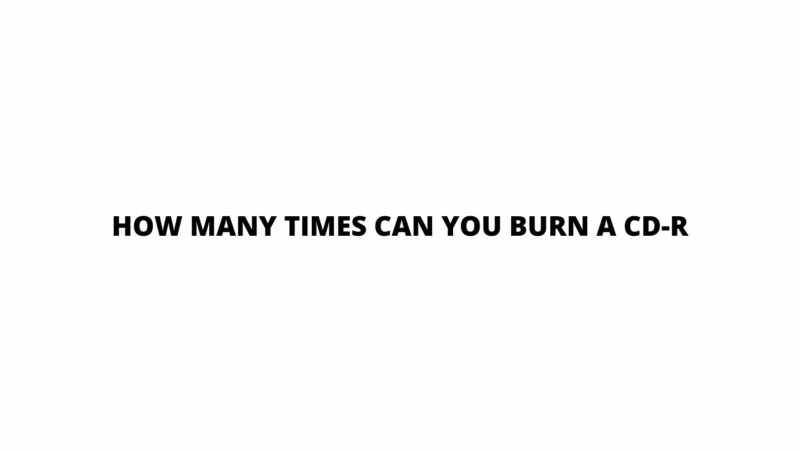The world of digital storage has evolved dramatically over the years, and yet, the venerable CD-R (Compact Disc-Recordable) continues to be a prominent player in archiving, distributing, and sharing data. However, a fundamental question persists: How many times can you burn a CD-R before it reaches its limit? Delving into the intricacies of CD-R technology, this article aims to unravel the factors that determine the maximum burn cycles of CD-R discs, the mechanisms that govern their endurance, and how users can make the most of this versatile storage medium.
- The Essence of CD-R Technology
At the heart of CD-R technology lies the ability to record data onto a blank CD-R disc using a laser. This process involves creating microscopic pits and lands on a dye layer within the disc. These pits and lands represent binary data that is later read by CD players and drives. The simplicity and convenience of CD-Rs have made them a staple in various applications, from creating music albums to backing up critical files.
- The Myth of Infinite Reusability
While CD-R technology is remarkable, it’s important to dispel a common misconception: CD-R discs are not infinitely reusable like rewritable CD-RW discs. CD-R discs belong to the category of write-once media. Once data is burned onto them, it becomes a permanent part of the disc, and this data cannot be erased or overwritten. This is in contrast to CD-RW discs, which can be rewritten multiple times.
- Decoding the Maximum Burn Cycles
The maximum burn cycles of CD-R discs depend on the inherent properties of the dye layer used in their construction. The dye layer is essential for recording data and plays a pivotal role in determining the disc’s longevity. High-quality CD-R discs tend to have dye layers that are more stable and durable, contributing to their ability to withstand multiple burn cycles.
- The Role of Dye Layers
The dye layer within a CD-R disc is sensitive to the laser’s energy during the burning process. The laser’s intensity heats the dye layer, creating pits and lands that represent binary data. Over multiple burn cycles, the dye layer experiences stress from the heating and cooling cycles, potentially leading to degradation. High-quality dye layers can endure more burn cycles before significant degradation occurs.
- Quality vs. Quantity: Assessing CD-R Longevity
The maximum burn cycles of CD-R discs vary based on the quality of the dye layer and the disc’s manufacturing standards. Reputable manufacturers adhere to strict quality control measures that result in discs with dye layers designed to withstand numerous burn cycles. However, it’s important to note that there is no standardized number of maximum burn cycles for all CD-R discs, as it varies between manufacturers and product lines.
- Factors Influencing CD-R Longevity
Several factors influence the longevity of CD-R discs and the number of burn cycles they can endure:
- Dye Quality: High-quality dye layers are less prone to degradation from repeated heating and cooling cycles, allowing for more burn cycles.
- Manufacturing: Discs manufactured with precision and attention to detail tend to have more durable dye layers, contributing to a higher number of burn cycles.
- Burn Speed: Burning data at higher speeds generates more heat and stress on the dye layer. Lower burn speeds can help extend the lifespan of the dye layer and the disc itself.
- Storage Conditions: Proper storage in a cool, dark, and dry environment minimizes environmental factors that contribute to dye layer degradation.
- Handling Practices: Careful handling to prevent scratches and physical damage helps maintain the integrity of the dye layer over time.
- Strategies for Maximizing CD-R Longevity
To make the most of the maximum burn cycles of CD-R discs, consider the following strategies:
- Choose Quality: Opt for high-quality CD-R discs from reputable manufacturers known for producing durable and reliable products.
- Burn at Lower Speeds: When burning data onto CD-R discs, select lower burn speeds to reduce the stress on the dye layer.
- Store Properly: Store CD-R discs in a controlled environment away from extreme temperatures, humidity, and direct sunlight.
- Make Backups: Create backups of CD-R data on other storage solutions to mitigate the risk of data loss due to disc degradation.
- Alternatives and Future Trends
As technology continues to evolve, CD-R discs face competition from more advanced storage solutions, such as solid-state drives (SSDs), cloud storage, and high-capacity USB drives. These alternatives offer benefits like faster access times, larger storage capacities, and enhanced durability.
Conclusion
The question of how many times you can burn a CD-R disc sheds light on the dynamic interplay between technology, materials science, and data preservation. CD-R technology has revolutionized the way we store and share information, offering a unique balance of convenience and permanence. While CD-Rs are not infinitely reusable, their potential for multiple burn cycles is influenced by factors such as dye quality, manufacturing standards, burn speed, storage conditions, and handling practices.
As technology continues its march forward, the maximum burn cycles of CD-R discs are a reminder of their enduring relevance. By selecting high-quality discs, practicing proper storage and handling, and exploring alternatives, users can make the most of their CD-R storage solutions and ensure that their valuable data remains accessible for years to come.


